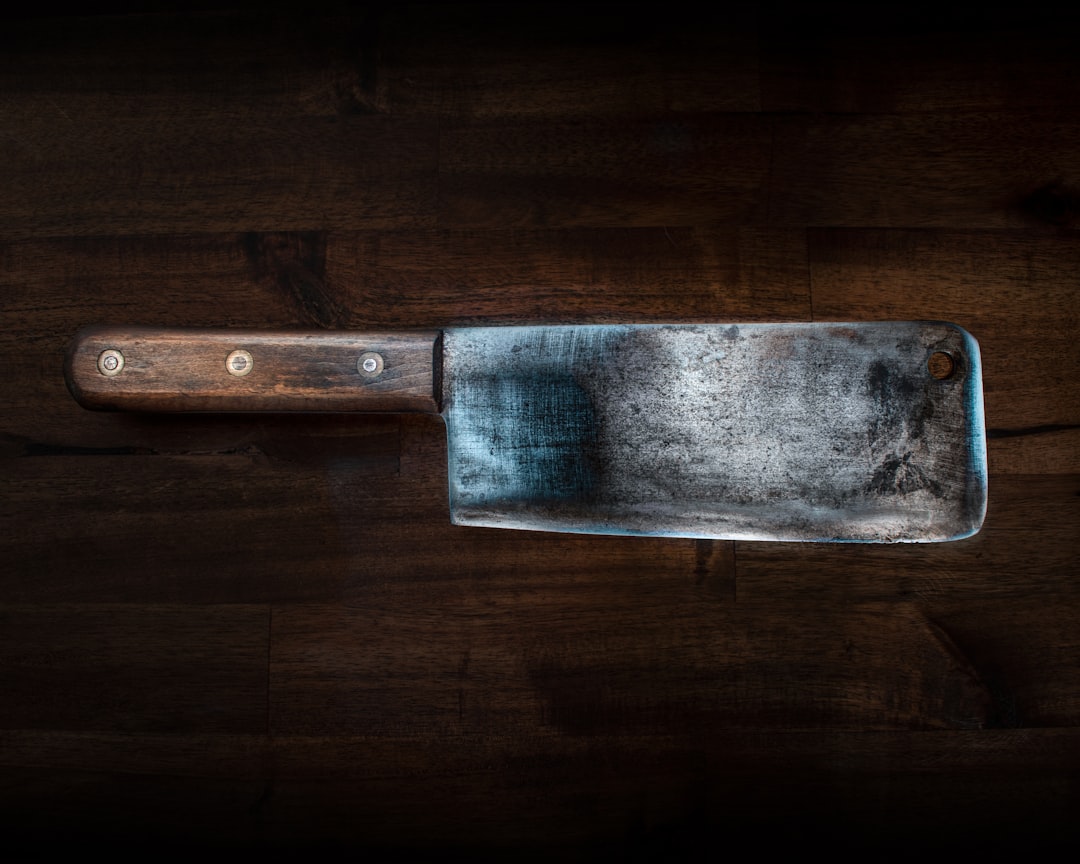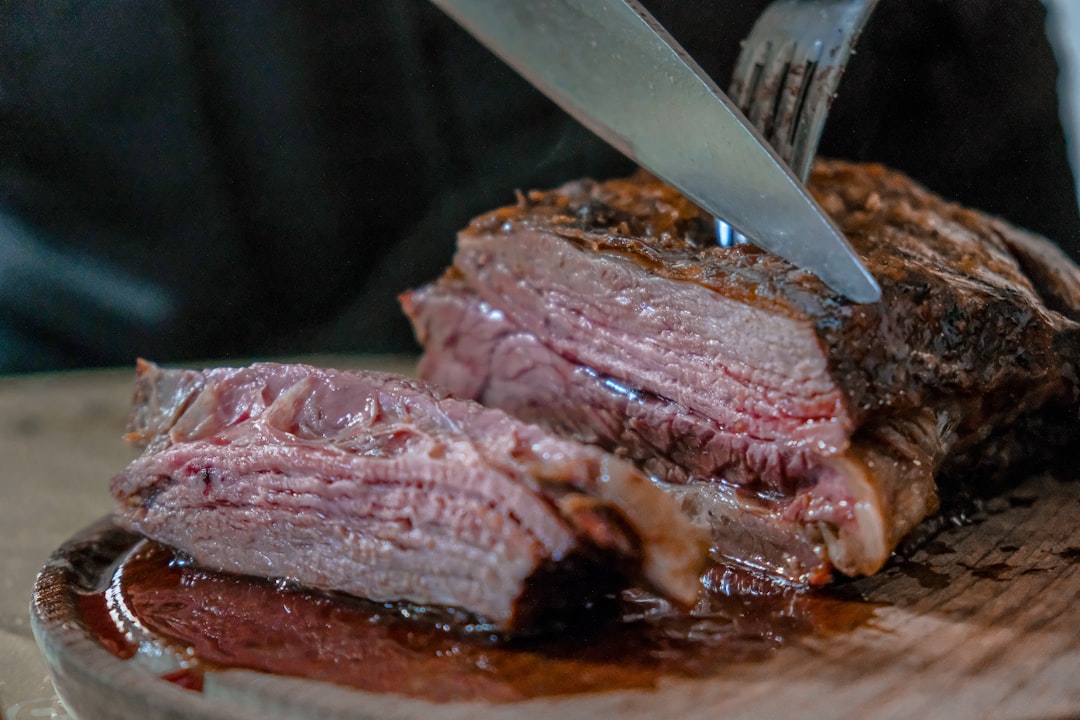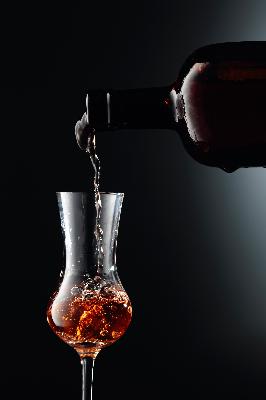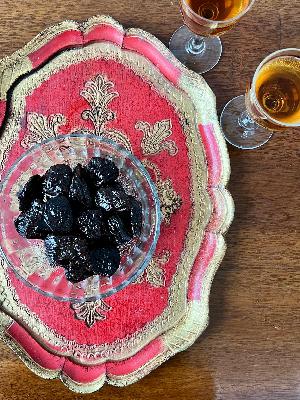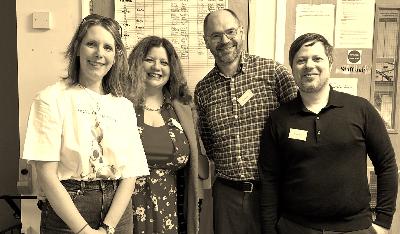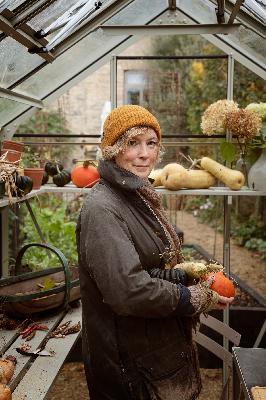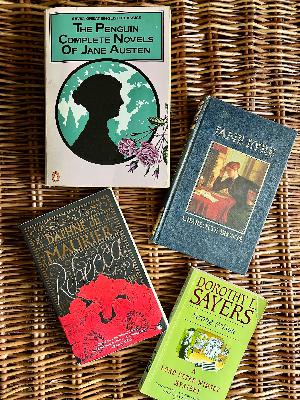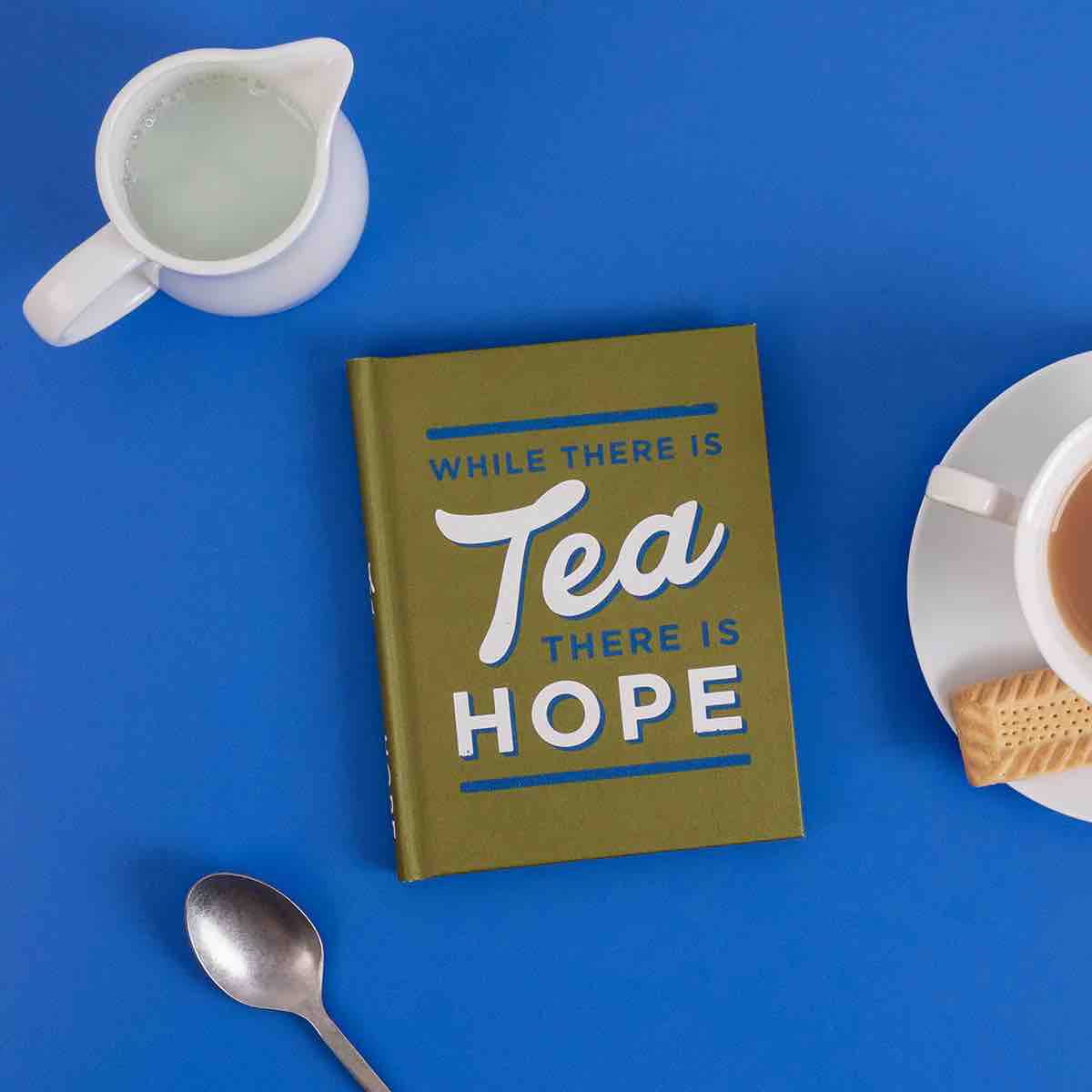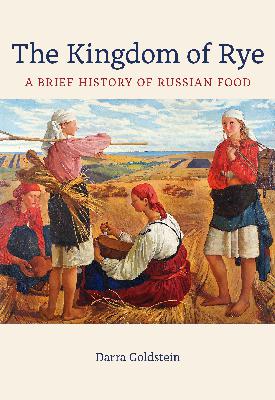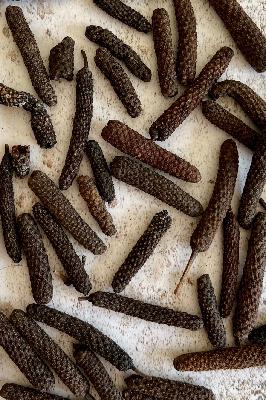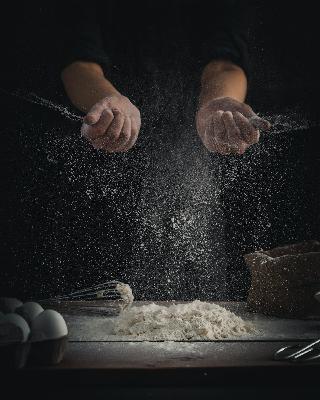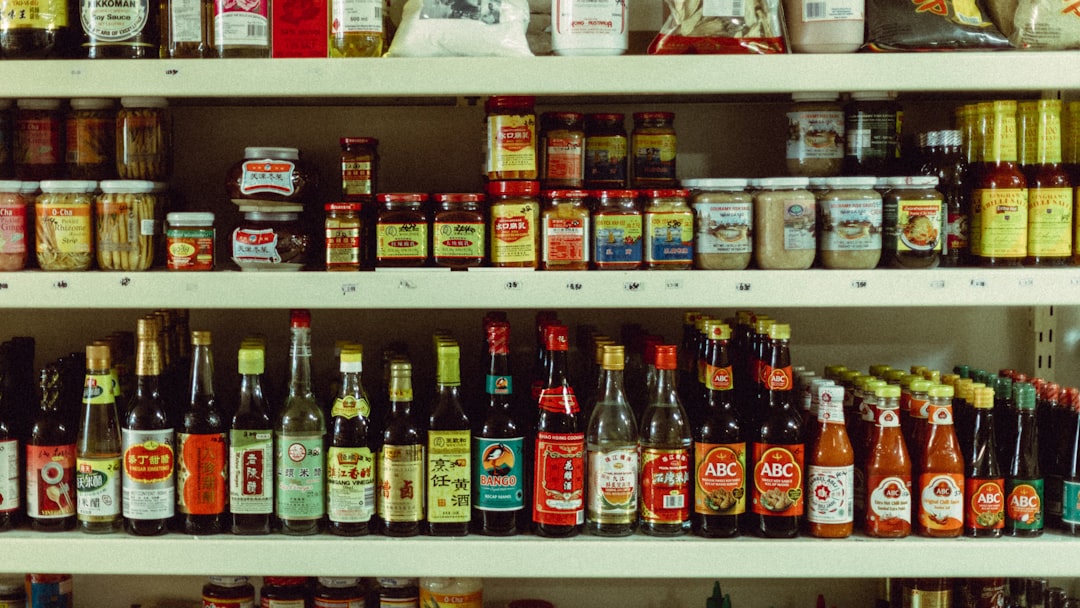Discover Comfortably Hungry
Comfortably Hungry

Comfortably Hungry
Author: Sam Bilton
Subscribed: 12Played: 197Subscribe
Share
© Sam Bilton
Description
Welcome to the award winning Comfortably Hungry podcast where yesterday’s dinner is tomorrow’s history. If you’re a peckish person who is curious about the history of food and drink, then you’re in the right place. I’m Sam Bilton a food historian, writer and cook and each season I will be joined by some hungry guests to discuss a variety topics centred around a specific theme. As a former supper club host I’m always intrigued to know what people like to eat. So to whet everyone’s appetites I have invited my guests to contribute a virtual dish with them inspired by today’s topic.
comfortablyhungry.substack.com
comfortablyhungry.substack.com
52 Episodes
Reverse
If you’re a fan of Jane Austen you’ll be familiar with the concept of ‘taking the waters’. In fact the title of today’s episode comes from a letter Jane wrote to her sister Cassandra who was staying in the spa town of Cheltenham in September 1816. People have been visiting places renowned for their mineral rich waters for centuries. These special wells, streams and pools were believed to cure all manner of ailments either by drinking or bathing in the water.In the first part of today’s episode I’m joined by multidisciplinary artist Gaylene Gould and local historian and guide Emanuela Aru Kay to tell me more about the Mary Woolaston, a Black woman who managed a healing well in seventeenth century London. Then Chris Jones of the Tunbridge Wells Civic society chats to me about the rise and fall of the Kentish spa town Tunbridge Wells.If you enjoyed the podcast you can become a paid subscriber to the Comfortably Hungry Substack (which means you’ll receive additional content such as recipes or extra audio) or show your appreciation by leaving a small, one off tip here. Useful LinksFind out more about Gaylene Gould on her website or follow here on Instagram. You can also find an essay on Black Mary in Thirst. Black Mary also features in the exhibition of the same name at the Wellcome Collection.Follow Emanuela Aru Kay on Instagram and more about the tours she runs through History from Below (which includes a tour uncovering hidden waters). You can also read Emanuela’s essay on ‘Reviving London’s Hidden Healing Legacy: The Black Mary Project And The Story Of Black Mary’s Well’ which includes images of where Black Mary’s Well was located (spoiler alert – the area has been densely built up over the years so the well and the stream that feeds it are no longer visible.)For a more tranquil idea of a healing well visit the Calthorpe Community Gardens (find out more via their website or Instagram) where you can view Marcia Bennett-Male’s statue of Mary. Find out more about Marcia who is the UK’s only black female sculptor on her website and Instagram.The Quentin Blake Centre for Illustration opens in May 2026The Tunbridge Wells Civic Society produces are number of books on the history of the area including The Pantiles: A Brief History by Philip Whitbourn & Chris Jones. The Chaleybeate Spring in The PantilesSuggested ReadingFor a list of nineteenth century spas and their purported benefits take a look at B. Bradshaw’s dictionary of mineral waters, climatic health resorts [&c.] ... of the world (1882)Cures and Curses: Ritual and Cult at Holy Wells by Janet Bord (available to download as a free pdf)Holy Wells in Britain: A Guide by Janet Bord (available to download as a free pdf)You can find out more about St Winefride’s Holy Well here or in this short YouTube video.The Journeys of Ceilia Fiennes (1947) available via Internet Archive.A Medical topography of Tunbridge Wells by Dr Robert Powell (1846)The History and Description of the Parish of Clerkenwell by Thomas Cromwell (1828)Don’t forget you can follow me on Instagram or Bluesky @mrssbilton or find out more about my work on sambilton.com.A huge thank you to Thomas Ntinas of The Delicious Legacy for doing the sound mixing on this season of the podcast.Comfortably Hungry is a reader-supported publication. To receive new posts and support my work, consider becoming a free or paid subscriber. Get full access to Comfortably Hungry at comfortablyhungry.substack.com/subscribe
Welcome back! In Episode 1 of this new season I’m joined by Cass Gardiner, an Anishinaabe Algonquin filmmaker, curator, and writer from Kebaowek First Nation to discuss manoomin, or wild rice, and its importance to First Nation people in North America. We talk about its spiritual and economic significance and how this aspect of the Anishinaabe way of life is under threat from environmental pollution, displacement and climate change.As well as a new season of Comfortably Hungry, there’s also Serve It Forth festive event to look forward to called A Christmas Feast of the Uncanny (think of it as a spookier version of Dickens’ A Christmas Carol without the schmaltz!)If you enjoyed the podcast you can become a paid subscriber to the Comfortably Hungry Substack (which means you’ll receive additional content) or show your appreciation by leaving a small, one off tip here. Useful LinksCass Gardiner’s website and on Instagram.The Academy of Natural Sciences of Drexel University’s new exhibition: Botany of Nations opens on March 28, 2026 and runs until February 14, 2027. It aims to inspire civic dialogue and reshape the historic Corps of Discovery (1804 – 1806) tale of Meriwether Lewis and William Clark with Indigenous perspectives against the backdrop of the United States’ 250th anniversary. Cass’s film of the same name will form part of the exhibition. Cass will also be acting as Guest Editor for the autumn ‘26 edition of Petits Propos Culinaires which will explore similar perspectives.Winona LaDuke’s TEDx talk Seeds of Our Ancestors, Seeds of LifeWinona LaDuke: Return to Rice Lake: Anishinaabe celebration welcomes runners honoring — and protecting — the sacred manoominPhoto essay on wild rice harvest via Canada’s HistoryOwamni Restaraunt in Minneapolis, Minnesota restaurant where the entire menu is pre-colonial foods only. Sean Sherman’s first cookbook, The Sioux Chef’s Indigenous Kitchen, was published in 2017 and his latest cookbook Turtle Island is out now.Chef Crystal Wahpepah restaurant, Wapepah’s Kitchen is in Oakland, California. Crystal released a new cookbook this year, A Feather and a Fork: 125 Intertribal Dishes from an Indigenous Food Warrior.Chef Pyet DeSpain, who is a caterer and also has a cookbook that is coming out soon, Rooted In FireSuggested ReadingTo be a Water Protector - Winona LaDuke (2020)Don’t forget you can follow me on Instagram or Bluesky @mrssbilton or find out more about my work on sambilton.com. You can also listen to the podcast and see short cookery videos on the new Comfortably Hungry YouTube channel.A huge thank you to Thomas Ntinas of The Delicious Legacy for doing the sound mixing on this season of the podcast.Comfortably Hungry is a reader-supported publication. To receive new posts and support my work, consider becoming a free or paid subscriber. Get full access to Comfortably Hungry at comfortablyhungry.substack.com/subscribe
Season 4 of the Comfortably Hungry podcast will start in earnest later this autumn. This season I’ll be chatting to historians, food writers, and artists to reveal the importance of water in all its guises and how it was used by our ancestors. To whet your appetite I had a chat with Janice Li, curator of a new exhibition at the Wellcome Collection in London called Thirst: In Search of Freshwater.You’ve no doubt heard the statistic that around 70 percent of the earth’s surface is covered with water. What may come as a surprise, as it did for me, is that only three percent of that water is fresh. And it is that limited resource and how it has been harnessed in the past to produce and preserve our food and drink that is the focus of Season 4.If you enjoyed the podcast you can become a paid subscriber to the Comfortably Hungry Substack (which means you’ll receive additional content) or show your appreciation by leaving a small, one off tip here. Useful Links* Thirst: In Search of Freshwater at the Wellcome Collection is open from 25 June 2025 to 1 February 2026.* Thirst: In Search of Freshwater book* Find out more about Janice Li’s work on her website or follow her on Instagram.Don’t forget you can follow me on Instagram or Bluesky @mrssbilton or find out more about my work on sambilton.com.A huge thank you to Thomas Ntinas of The Delicious Legacy for doing the sound mixing on this season of the podcast.Comfortably Hungry is a reader-supported publication. To receive new posts and support my work, consider becoming a free or paid subscriber. Get full access to Comfortably Hungry at comfortablyhungry.substack.com/subscribe
Alice B Toklas reckoned that ‘food is far too pleasant to combine with horror.’ In Episode 13 I will be exploring how food is used in crime fiction with writer and host of the Shedunnit podcast Caroline Crampton and food writer and author of the Paul Delamare mysteries, Orlando Murrin.Don’t forget to check out the Comfortably Hungry Substack!Useful Links* Orlando’s thrilling Paul Delamare Mysteries Knife Skills for Beginners and Murder Below Deck are available now.* Orlando has written lots of delicious cookery books too including Two’s Company: The best of cooking for couples, friends and roommates * Orlando’s website* Caroline’s website* Shedunnit podcast* Caroline’s books include A Body Made of Glass: A History of Hypochondria (now available in paperback) and The Way to the Sea: The Forgotten Histories of the Thames Estuary Suggested ReadingWe talked about a lot of books in this episode so here are just a few that we mentioned:* Alice B Toklas Cookbook* The Pimlico Poisoning* The Poisoned Chocolate Case by Anthony Berkeley* ‘The Tuesday Night Club’ in The Thirteen Problems by Agatha Christie* A Pocket Full of Rye by Agatha ChristieDon’t forget you can follow me on Instagram or Bluesky @mrssbilton or find out more about my work on sambilton.com.A huge thank you to Thomas Ntinas of The Delicious Legacy for doing the sound mixing on this season of the podcast.Comfortably Hungry is a reader-supported publication. To receive new posts and support my work, consider becoming a free or paid subscriber. Get full access to Comfortably Hungry at comfortablyhungry.substack.com/subscribe
In an essay entitled “Feasts are too Proud / Better to Starve”: Shakespearean Culinary Divides, Sheila T. Cavanagh, Professor of English at Emory University explains that in Shakespeare’s plays ‘Disputes involving food … often reveal close convergences between dietary options and challenging loci of interpersonal conflict, frequently connected with competing hierarchies associated with status as well as domestic, political, financial, or social power.’In today’s episode Sheila will help me explore how food is weaponised in Shakespeare’s plays, both in a literal and figurative sense, to coerce or punish characters.As a special treat for my listeners I’m extending a 25% discount off the full ticket price for the Serve It Forth Food History Festival on 18 October 2025. I’ll be there continuing my discussion on Food in Shakespeare. Just enter SERVE25 at the checkout to claim the discount.If you enjoyed the podcast you can become a paid subscriber to the Comfortably Hungry Substack (which means you’ll receive additional content) or show your appreciation by leaving a small, one off tip here. Don’t forget that you can find links to the books discussed in today’s and other episodes on the Comfortably Hungry Bookshelf on Substack. Much Ado About Cooking is available to pre-order ahead of its release on 23 October 2025.Don’t forget you can follow me on Instagram or Bluesky @mrssbilton or find out more about my work on sambilton.com.A huge thank you to Thomas Ntinas of The Delicious Legacy for doing the sound mixing on this season of the podcast.Comfortably Hungry is a reader-supported publication. To receive new posts and support my work, consider becoming a free or paid subscriber. Get full access to Comfortably Hungry at comfortablyhungry.substack.com/subscribe
One of the challenges of writing a cookbook based on early modern recipes, like Much Ado About Cooking, is that the culinary manuscripts food historians have at our disposal tell us very little about what ordinary people consumed. They record the food largely eaten by the rich or the upwardly mobile merchants and yeomen. As fascinating and delicious as many of these recipes are, they don’t reveal what the everyday folk ate. And this is where the works of playwrights like William Shakespeare are insightful.Helping me to dissect the food references in Shakespeare’s plays to solve this mystery is Diane Purkiss, Professor of English Literature for Keble College at the University of Oxford and author of English Food: A People’s History.As a special treat for my listeners I’m extending a 25% discount off the full ticket price for the Serve It Forth Food History Festival on 18 October 2025. I’ll be there continuing my discussion on Food in Shakespeare. Just enter SERVE25 at the checkout to claim the discount.If you enjoyed the podcast you can become a paid subscriber to the Comfortably Hungry Substack (which means you’ll receive additional content) or show your appreciation by leaving a small, one off tip here. Don’t forget that you can find links to the books discussed in today’s and other episodes on the Comfortably Hungry Bookshelf on Substack. Much Ado About Cooking is available to pre-order ahead of its release on 23 October 2025.Don’t forget you can follow me on Instagram or Bluesky @mrssbilton or find out more about my work on sambilton.com.A huge thank you to Thomas Ntinas of The Delicious Legacy for doing the sound mixing on this season of the podcast.Comfortably Hungry is a reader-supported publication. To receive new posts and support my work, consider becoming a free or paid subscriber. Get full access to Comfortably Hungry at comfortablyhungry.substack.com/subscribe
Following on from my discussions with Diane Purkiss, Sheila Cavanagh and Will Tosh on the less obvious meanings behind the food in Shakespeare’s plays I thought it would be fun to find out more about the early modern foods that are less well-known today or have entirely disappeared.In this episode I chat to Victoria González Gordón of Gonzalez Byass about Sir John Falstaff’s favourite tipple, sack. Wave the flag for the revival of the humble medlar with Jane Steward of Eastgate Larder and try to get to the bottom of what sort of cheese came from Banbury and why it has disappeared.Useful LinksMy latest book Much Ado About Cooking: Delicious Shakespearean Feasts for Every Occasion is out now from all good bookshops.You can find more about Ned Palmer at The Cheese Tasting Co. Ned has written three books including A Cheesemonger’s History of the British Isles. You can also find him on Instagram and Substack.You can find out more about Jane Steward and medlars on the Eastgate Larder website or in her book Medlars: Growing and Cooking. Jane is also on Instagram.For further details on the history of Gonzalez Byass visit their website. Victoria mentioned Sherry: The Noble Wine by Manuel Gonzalez-Gordon. This appears to be out of print now but you can pick up second hand copies via Abe Books or similar. The best place to follow Gonzalez Byass is via the Tio Pepe Wines Instagram.Don’t forget you can follow me on Instagram or Bluesky @mrssbilton or find out more about my work on sambilton.com.A huge thank you to Thomas Ntinas of The Delicious Legacy for doing the sound mixing on this season of the podcast.Comfortably Hungry is a reader-supported publication. To receive new posts and support my work, consider becoming a free or paid subscriber. Get full access to Comfortably Hungry at comfortablyhungry.substack.com/subscribe
As the title of this podcast suggests much of the discussion around the following episode centres on SEX. So, if you are travelling in the car with young people or anyone who is easily offended you may want to wait until you have dropped them off!Sex is, and always has been, a part of our lives. Without it none of us would be here. The very mention of the word can elicit titters, blushes, disgust and arousal. Shakespeare’s plays are teeming with sexual inuendo often with reference to food. Helping me unpick exactly what the Bard meant by these saucy references is Dr Will Tosh, Director of Education at Shakespeare’s Globe and author of Straight Acting: The Many Queer Lives of William Shakespeare and several other books.This is the last chance for listeners to claim their 25% off tickets for the Serve It Forth Festival on 18 October 2025! Enter SERVE25 at the checkout.If you enjoyed the podcast you can become a paid subscriber to the Comfortably Hungry Substack (which means you’ll receive additional content) or show your appreciation by leaving a small, one off tip here. Don’t forget that you can find links to the books discussed in today’s and other episodes on the Comfortably Hungry Bookshelf on Substack. Much Ado About Cooking is available to pre-order ahead of its release on 23 October 2025.Don’t forget you can follow me on Instagram or Bluesky @mrssbilton or find out more about my work on sambilton.com.A huge thank you to Thomas Ntinas of The Delicious Legacy for doing the sound mixing on this season of the podcast.Comfortably Hungry is a reader-supported publication. To receive new posts and support my work, consider becoming a free or paid subscriber. Get full access to Comfortably Hungry at comfortablyhungry.substack.com/subscribe
Ever wondered how someone gets into food history? What are the popular misconceptions about what we do? And do we ever have any recipe disasters?In this bonus episode I chat to my food history chums Neil Buttery, Alessandra Pino and Thomas Ntinas about how we got into food history and what inspires us. We also chat about our new food history festival, Serve It Forth, which will take place online on Saturday 18 October 2025 covering topics such as Falstaff’s love of food in Shakespeare’s plays; chefs from the Ancient Greek world; what the Thames can tell us about the feasting tables of the living and memento mori traditions; plus an interview with food writer Tom Parker Bowles about how we can keep food traditions alive. If you enjoyed the podcast you can become a paid subscriber to the Comfortably Hungry Substack (which means you’ll receive additional content) or show your appreciation by leaving a small, one off tip here. Useful LinksServe It Forth websiteServe It Forth ticketsServe It Forth on Social MediaDon’t forget you can follow me on Instagram or Bluesky @mrssbilton or find out more about my work on sambilton.com.A huge thank you to Thomas Ntinas of The Delicious Legacy for doing the sound mixing on this season of the podcast.Comfortably Hungry is a reader-supported publication. To receive new posts and support my work, consider becoming a free or paid subscriber. Get full access to Comfortably Hungry at comfortablyhungry.substack.com/subscribe
We heard briefly from food writer Kathy Slack about how gardening and cooking helped her overcome anxiety and depression back in Episode 10 of Season 3. Kathy is frank about her mental health struggles in her revealing book, Rough Patch. This is the partner piece to Ami Bouhassane’s interview about her grandmother Lee Miller.Don’t forget to check out the Comfortably Hungry Substack!Useful LinksYou can find out more about Kathy on her website and follow her on Instagram. Kathy has published two books:* From the Veg Patch: 10 favourite vegetables, 100 simple recipes everyone will love* Rough Patch: How a Year in the Garden Brought Me Back to Life* Don’t forget to check out Tales from the Veg Patch by Kathy on SubstackIf you enjoyed the podcast you can become a paid subscriber to the Comfortably Hungry Substack (which means you’ll receive additional content) or show your appreciation by leaving a small, one off tip here. Don’t forget you can follow me on Instagram or Bluesky @mrssbilton or find out more about my work on sambilton.com.A huge thank you to Thomas Ntinas of The Delicious Legacy for doing the sound mixing on this season of the podcast.Comfortably Hungry is a reader-supported publication. To receive new posts and support my work, consider becoming a free or paid subscriber. Get full access to Comfortably Hungry at comfortablyhungry.substack.com/subscribe
In this bonus episode I take a look at how some of our best loved authors portray food in their books; why some fiction genres enjoy an enduring popularity and introduce you to the alter ego of a famous food writer. Joining me on this literary romp are some familiar Comfortably Hungry voices (Caroline Crampton, Orlando Murrin and Dr Alessandra Pino) and some new guests (Pen Vogler and Dr Kevin Geddes).If you enjoyed the podcast you can become a paid subscriber to the Comfortably Hungry Substack (which means you’ll receive additional content) or show your appreciation by leaving a small, one off tip here. Useful Links* Allie is offering Comfortably Hungry listener’s a discount on her Fresh from the Crypt T-shirts - https://www.freshfromthecrypt.com/ discount code is: COMFORTABLYSPOOKY10* The Politics of Pudding: The Past, Present and Future of Yorkshire Food by Pen Vogler at the Ryedale Folk Museum on 12 July 2025 at 2pm* ‘40% of Britons haven’t read a single book in the last 12 months’ Dylan Difford, YouGov March 05, 2025* Shedunnit podcast* Murder in the Kitchen with Caroline Crampton and Orlando Murrin (CHS3 Episode 13)* Death by chocolate with Dr Alessandra Pino and Sue Lawrence (CHS2 Episode 3 )Reading List* Orlando’s thrilling Paul Delamare Mysteries Knife Skills for Beginners and Murder Below Deck are available now.* Caroline’s books include A Body Made of Glass: A History of Hypochondria (now available in paperback) and The Way to the Sea: The Forgotten Histories of the Thames Estuary* The Many Careers of Fanny Cradock by Kevin Geddes* The Sherlock Holmes Cookbook by Mrs Hudson (Compiled by Fanny Cradock)* Dinner with Mr Darcy by Pen Vogler* Tea with Jane Austen by Pen Vogler* Scoff by Pen Vogler* Stuffed by Pen Vogler* Martha Lloyd's Household Book: The Original Manuscript from Jane Austen's Kitchen by Deirdre le Faye* A Gothic Cookbook by Ella Buchan and Dr Alessandra PinoDon’t forget you can follow me on Instagram or Bluesky @mrssbilton or find out more about my work on sambilton.com.A huge thank you to Thomas Ntinas of The Delicious Legacy for doing the sound mixing on this season of the podcast.Comfortably Hungry is a reader-supported publication. To receive new posts and support my work, consider becoming a free or paid subscriber. Get full access to Comfortably Hungry at comfortablyhungry.substack.com/subscribe
As promised this is the full version of the interview I did with Ami Bouhassane, co-director of the Lee Miller Archives and Farley’s House and Gallery in Sussex, and granddaughter of model, photographer, writer and cook Lee Miller.Ami and I delve further into Lee’s career as a photographer and journalist during World War 2 and a childhood trauma (which some listener’s may find upsetting) - experiences which left her with PTSD and struggling with depression in the later years of her life. We also explore Lee’s love of fitted kitchens, cookery competitions and ‘working’ guests.Useful LinksTo see examples of Lee Miller’s photography visit the Lee Miller Archives online.Farleys House & Gallery and on InstagramBooks on Lee’s work including her cookbook A Life with Food, Friends and Recipes can be found here.Chloe Edwards of Seven Sisters Spices runs cookery workshops at Farleys often using Lee’s recipes.Suggested ReadingThe Lives of Lee Miller by Antony PenroseLee Miller: Photographs by Antony Penrose and Kate WinsletDon’t forget you can follow me on Instagram or Bluesky @mrssbilton or find out more about my work on sambilton.com.A huge thank you to Thomas Ntinas of The Delicious Legacy for doing the sound mixing on this season of the podcast.Comfortably Hungry is a reader-supported publication. To receive new posts and support my work, consider becoming a free or paid subscriber. Get full access to Comfortably Hungry at comfortablyhungry.substack.com/subscribe
Today is the 80th anniversary of VE Day, the day the second world war ended in Europe. To mark the occasion I had a chat with journalist and author Alex Johnson about the importance of tea to the British during this conflict. Alex’s latest book While There Is Tea, There Is Hope, published in conjunction with the Imperial War Museum, is packed with wartime ephemera, photographs and vintage recipes.If you enjoyed the podcast you can become a paid subscriber to the Comfortably Hungry Substack (which means you’ll receive additional content) or show your appreciation by leaving a small, one off tip here. Useful LinksYou can find out more about Alex’s work and books on his website. While There Is Tea, There Is HopeMenus That Made HistoryYou can also find Alex on Instagram Imperial War Museum Collections holds a wealth of photographic material from the second world war.Imperial War MuseumDonald Pleasance in The Great EscapeDon’t forget you can follow me on Instagram or Bluesky @mrssbilton or find out more about my work on sambilton.com.A huge thank you to Thomas Ntinas of The Delicious Legacy for doing the sound mixing on this season of the podcast.Comfortably Hungry is a reader-supported publication. To receive new posts and support my work, consider becoming a free or paid subscriber. Get full access to Comfortably Hungry at comfortablyhungry.substack.com/subscribe
Alas this day had to come - this is the last official episode of the DARK season!In Episode 15 I delve into the historical culinary trials and tribulations of Russia with Darra Goldstein, Professor Emerita of Russian at Williams College (USA) and author of The Kingdom of Rye: A Brief History of Russian Food. We discuss the importance of ‘black’ rye bread which is at the heart of any traditional Russian meal; the folklore surrounding it and how Russians survived during periods of privation.Useful LinksYou can find out more about Darra and her work on her website which contains some mouthwatering sample recipes. You can also follow Darra on Instagram. Darra’s books include:* The Kingdom of Rye: A Brief History of Russian Food* Beyond the North Wind: Recipes and Stories from Russia* Fire and Ice: Classic Nordic Cooking: Classic Nordic Cooking* Darra has written a range of books on preservation co-authored with Cortney Burns. Topics include vegetables, fruit and drinks.* Darra is also Editor In Chief of the Oxford Research Encyclopaedia of Food Studies. If you’re interested in ancient grains like rye you may also want to check out Ruth Nieman Substack and her book Freekeh, Wild Wheat & Ancient Grains: Recipes for Healthy Eating.This is the last official episode of the season but there will be a few inter-season episodes dropping over the coming months to sustain you! Listen to the end of episode 15 to discover the theme for Season 4.If you enjoyed this season please consider leaving a small tip to help support the podcast for future seasons.Don’t forget to check out the Comfortably Hungry Substack!Don’t forget you can follow me on Instagram or Bluesky @mrssbilton or find out more about my work on sambilton.com.A huge thank you to Thomas Ntinas of The Delicious Legacy for doing the sound mixing on this season of the podcast.Comfortably Hungry is a reader-supported publication. To receive new posts and support my work, consider becoming a paid subscriber. Get full access to Comfortably Hungry at comfortablyhungry.substack.com/subscribe
In Episode 14 I get passionate about a particular type of pepper which was once so highly prized the Visigoths demand 3000lb of the stuff to leave Rome. Joining me to explore the history and usage of this spice are Giles Gasper, Professor of High Medieval History and Florence Swan from Durham University and food writer and author of Pepper, Christine McFaddenDon’t forget to check out the Comfortably Hungry Substack!Useful LinksYou can find Christine McFadden on Instagram and Facebook Don’t forget to check out Christine’s book on Pepper Blackfriars Restaurant in Newcastle where you will find details of their upcoming events and the Eat Medieval summer schoolProfessor Giles Gasper, Durham University You can find Florence Swan on InstagramLong pepper can be bought in the UK from Steenbergs and Seasoned Pioneers Don’t forget to check out the episode on Anglo-Saxon food with historian Emma Kay.Suggested Reading* Forme of Cury * Natural Histories - Pliny* Apicius (this is just one of many translations)* Le Menagier de Paris (or Goodman of Paris)* Sir John Russell’s Book of Nurture* Le Viander - Guilluame Tirrell* John de Mandeville - Mandeville’s TravelsDon’t forget you can follow me on Instagram or Bluesky @mrssbilton or find out more about my work on sambilton.com.A huge thank you to Thomas Ntinas of The Delicious Legacy for doing the sound mixing on this season of the podcast.Comfortably Hungry is a reader-supported publication. To receive new posts and support my work, consider becoming a free or paid subscriber. Get full access to Comfortably Hungry at comfortablyhungry.substack.com/subscribe
In the first part (Episode 10) of this investigation into the impact food has on our mental health I explored the renaissance fascination with melancholy with Professor Mary Ann Lund and food historian Ken Albala. In Episode 12 I want to find out how gardening and cooking in particular have helped two modern cooks deal with anxiety and depression. I had a chat with Ami Bouhassane, co-director of the Lee Miller Archives and Farley’s House and Gallery in Sussex. Ami’s grandmother was model, photographer, writer and cook Lee Miller who battled with depression in the later years of her life. Food writer Kathy Slack reveals how gardening and cooking helped her overcome anxiety and depression in her latest book, Rough Patch.This is a bumper episode so a bit longer than usual. Full length interviews with both Ami and Kathy will be released later in the year.Don’t forget to check out the Comfortably Hungry Substack!Also, I will be speaking at the annual Scottish Food Heritage Symposium on 28 March 2025. You can find more details here.Useful LinksTo see examples of Lee Miller’s photography visit the Lee Miller Archives online.Farleys House & Gallery and on InstagramBooks on Lee’s work including her cookbook A Life with Food, Friends and Recipes can be found here.Chloe Edwards of Seven Sisters Spices runs cookery workshops at Farleys often using Lee’s recipes.You can find out more about Kathy on her website and follow her on Instagram. Kathy has published two books: * From the Veg Patch: 10 favourite vegetables, 100 simple recipes everyone will love* Rough Patch: How a Year in the Garden Brought Me Back to Life* You can find out more about the French Field to Fork Experience 19-23 June 2025 in France that Kathy is involved in here.Suggested ReadingThe Lives of Lee Miller by Antony PenroseLee Miller: Photographs by Antony Penrose and Kate WinsletDon’t forget you can follow me on Instagram or Bluesky @mrssbilton or find out more about my work on sambilton.com.A huge thank you to Thomas Ntinas of The Delicious Legacy for doing the sound mixing on this season of the podcast.Comfortably Hungry is a reader-supported publication. To receive new posts and support my work, consider becoming a free or paid subscriber. Get full access to Comfortably Hungry at comfortablyhungry.substack.com/subscribe
In Episode 11 I am investigating a fruit with a bit of an image problem. Carob (Ceratonia siliqua) is the fruit of an evergreen tree native to the Mediterranean. The view of carob as a subsistence food has perhaps tarnished this fruit’s reputation. Yet despite this, the carob grown in the Ragusa district of Sicily has earned a place in the Slow Food Ark of Taste where it is described as having ‘a taste similar to cocoa with hints of honey and caramel, so much so that in ancient times in Sicily it was considered the “poor persons chocolate”.’ In recent years carob has been praised for its healthy credentials being a good source of dietary fibre and antioxidants. However, today it is more likely to be fed to animals than used in a kitchen. So why is it not more widely used in cookery? To help me answer this question I chat to historian Mary Taylor Simeti and food writer Angela Zaher.Useful LinksAngela Zaher’s website. You can also follow Angela on Instagram.Mary Taylor Simeti’s books include:* Pomp and Sustenance: Twenty-five Centuries of Sicilian Food* Bitter Almonds: Recollections and recipes from a Sicilian girlhood (with Maria Grammatico)* On Persephone's Island: A Sicilian Journal* Travels With a Medieval QueenYou can also find Mary on Instagram.Suggested Reading* Slow Food on Carob* ‘How Carob Traumatized a Generation’ by Jonathan Kauffman for the New Yorker* I Malavoglia by Giovanni Verga (1881) was translated by Mary A Craig and published in English as The House by the Medlar-Tree (1890)* ‘Carob: The “Poor Man’s Chocolate”’ by Jo Vraca for Italy SegretaDon’t forget you can follow me on Instagram or Bluesky @mrssbilton or find out more about my work on sambilton.com.A huge thank you to Thomas Ntinas of The Delicious Legacy for doing the sound mixing on this season of the podcast.Comfortably Hungry is a reader-supported publication. To receive new posts and support my work, consider becoming a free or paid subscriber. Get full access to Comfortably Hungry at comfortablyhungry.substack.com/subscribe
They will act, conceive all extremes, contrarieties, and contradictions, and that in infinite varieties…Scarce two of two thousand concur in the same symptoms. The Tower of Babel never yielded such confusion of tongues, as the chaos melancholy doth variety of symptoms. - Robert Burton, The Anatomy of Melancholy, 1621In Episode 10 I take a look at the perplexing affliction of melancholy in the first of two episodes exploring the relationship between food and mental health.Early in the seventeenth century a Leicestershire clergyman Robert Burton set out to untangle complex yet bizarrely alluring renaissance disease of melancholy and its effects on mental and physical well being. His research culminated in The Anatomy of Melancholy, a lengthy treatise on how to identify and treat this illness.Joining me to discuss what melancholy was, Burton’s work and the role food played in exacerbating or treating the condition are Professor Mary Ann Lund of Leicester University and author of A User’s Guide of Melancholy and food historian Ken Albala and author of Eating Right in the Renaissance.Useful LinksKen has written many books over the years including:* Opulent Nosh: A Cookbook* Beans: A History * A Cultural History of Food in the Renaissance* Nuts: A Global HistoryYou can also find Ken on Instagram.Mary Ann’s books include:* A User’s Guide to Melancholy* Melancholy, Medicine and Religion in Early Modern England: Reading 'The Anatomy of MelancholySuggested Reading* The Anatomy of Melancholy by Robert BurtonDon’t forget you can follow me on Instagram or Bluesky @mrssbilton or find out more about my work on sambilton.com.A huge thank you to Thomas Ntinas of The Delicious Legacy for doing the sound mixing on this season of the podcast.Comfortably Hungry is a reader-supported publication. To receive new posts and support my work, consider becoming a free or paid subscriber. Get full access to Comfortably Hungry at comfortablyhungry.substack.com/subscribe
In Episode 9 I chat to Professor Thomas David DuBois of Beijing Normal University and author of China in Seven Banquets: A Flavourful History about the alchemy of fermentation and the importance of fermented foods (especially beans) in Chinese cuisine.Don’t forget to check out the Comfortably Hungry Substack!Useful LinksYou can find out more about Thomas on his website.China in Seven Banquets: A Flavourful HistoryDon’t forget you can follow me on Instagram or Bluesky @mrssbilton or find out more about my work on sambilton.com.A huge thank you to Thomas Ntinas of The Delicious Legacy for doing the sound mixing on this season of the podcast.Comfortably Hungry is a reader-supported publication. To receive new posts and support my work, consider becoming a free or paid subscriber. Get full access to Comfortably Hungry at comfortablyhungry.substack.com/subscribe
I thought it was about time I faced my own bête noire. So Episode 8 is devoted to my sweet shop nemesis liquorice. Helping me overcome my dislike of this confectionery is ScandiKitchen founder Brontë Aurell.Don’t forget to check out the Comfortably Hungry Substack!Useful LinksFind out more about Brontë on her website or follow her on Instagram.ScandiKitchen cafe and deli in London (also on Instagram)Brontë’s next cookbook Smorrebrod: Scandinavian Open Sandwiches is out on 8 April 2025.Brontë’s cookbooks include:* The ScandiKitchen Cookbook: Recipes for good food with love from Scandinavia * ScandiKitchen: Fika and Hygge: Comforting cakes and bakes from Scandinavia with love* ScandiKitchen: The Essence of Hygge* ScandiKitchen Summer: Simply delicious food for lighter, warmer days Suggested Reading* Adam in Eden, or, Natures paradise by William Coles, 1657* The History of Pontefract, in Yorkshire by George Fox, 1827* The herball, or, Generall historie of plantes by John Gerard, 1636* Mr Halley’s description of liquorice cultivation around Pontefract can be found in The review and abstract of the county reports to the Board of Agriculture; from the several agricultural departments of England. by Mr. Marshall v. 1* Delights for ladies: to adorne their persons, tables, closets, and distillatories. With beauties, banquets, perfumes, and waters by Hugh Platt, 1602* Chronicles of Old Pontefract by Lorenzo Radgett, 1905Don’t forget you can follow me on Instagram or Bluesky @mrssbilton or find out more about my work on sambilton.com.A huge thank you to Thomas Ntinas of The Delicious Legacy for doing the sound mixing on this season of the podcast.Comfortably Hungry is a reader-supported publication. To receive new posts and support my work, consider becoming a free or paid subscriber. Get full access to Comfortably Hungry at comfortablyhungry.substack.com/subscribe





